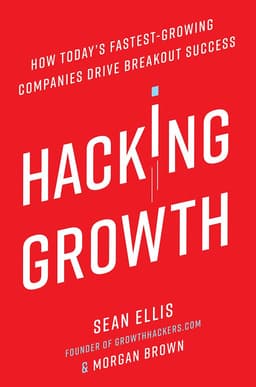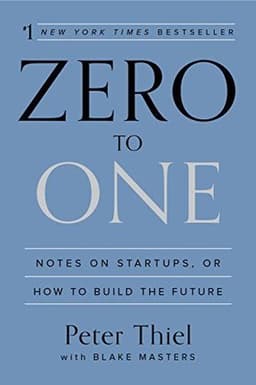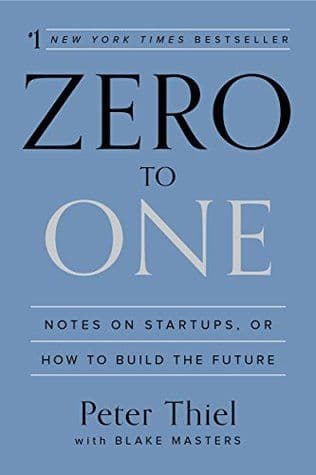
Hacking Growth Book Summary
How Today's Fastest-Growing Companies Drive Breakout Success
Book by Sean Ellis
Feeling Lazy?Read 1 Minute Summary
Summary
Hacking Growth reveals the revolutionary growth hacking techniques used by today's fastest-growing companies to drive breakout success - and shows you exactly how to implement them in your own organization.
Sign in to rate
Average Rating: 3.5
1. The Method
The Power of Cross-Functional Growth Teams
Chapter 1 discusses the importance of building cross-functional growth teams to drive rapid experimentation and growth.
- Growth teams should include members from marketing, engineering, product, and data analysis. This breaks down organizational silos. The team focuses relentlessly on a singular goal - driving growth through rapid experimentation and analysis.
- Growth teams work best when they have strong executive sponsorship and authority to work across normal organizational boundaries.
- Two common growth team structures are the independent model reporting to a growth lead, and the functional model embedded in product teams. The right structure depends on the company.
Section: 1, Chapter: 1
A Good Plan Violently Executed Now is Better Than a Perfect Plan Tomorrow
"A good plan violently executed now is better than a perfect plan tomorrow."
This quote, cited by Facebook's Alex Schultz, underscores a key growth team principle - moving quickly to ramp up the tempo of experimentation is more important than having a flawless, thoroughly debated plan. Analysis paralysis and over-planning are the enemies of growth. Growth teams must act decisively and with urgency.
Section: 1, Chapter: 1
Dropbox Grew From 100k to 4M Users in 14 Months With No Marketing Spend
Dropbox is a classic example of growth hacking success. With help from interim growth lead Sean Ellis, Dropbox:
- Created a referral program giving existing users 250MB of extra space for referring a friend, and giving referred users 250MB too. This offered a highly relevant reward for a storage product.
- Experimented extensively with the referral flow, optimizing all elements over many iterations.
- Grew from 100,000 to 4M users in just 14 months with these growth tactics, all with no traditional marketing spend on advertising, PR or promotions.
This demonstrates the power of growth teams focusing on product-led, viral growth tactics that can massively scale while keeping acquisition costs low.
Section: 1, Chapter: 1
The Must-Have Product Prerequisite for Growth
Chapter 2 explains that before focusing on rapidly scaling growth, companies must first ensure they have achieved product-market fit and are delivering a "must-have" experience to users. Ways to assess:
- Conducting a user survey asking how disappointed users would be if they could no longer use your product. If over 40% say "very disappointed", that indicates the product is must-have.
- Analyzing user retention data to see if retention stabilizes over time, ideally showing increased retention the longer users stay with the product. Declining retention is a red flag.
Making your product a must-have comes before growth tactics. Otherwise you risk scaling up a product that ultimately fails to retain users.
Section: 1, Chapter: 2
Using Metrics to Determine the Aha Moment
To identify your product's core value and "aha moment" that turns users into devoted fans, analyze user behavior data to find:
- The tipping point number of actions that engaged users take vs casual ones (e.g. Following 30 people on Twitter, adding 7 friends in 10 days on Facebook)
- The common actions that retained users take but lost users don't
- The key product features or parts of the user experience that most engage your fans
Then focus your user experience on driving more users to that aha moment as quickly as possible. For example, when Facebook identified adding 7 friends in 10 days as a key tipping point, they redesigned their new user experience to focus people on adding friends upfront.
Section: 1, Chapter: 2
Experimentation Velocity Determines the Pace of Growth
Chapter 3 focuses on why the pace of experimentation is crucial to the pace of growth:
- The faster you run experiments, the more you learn about what works and what doesn't. More experiments = more insights.
- Most experiments will fail or show inconclusive results. Growth comes from many small wins compounded over time vs one big win.
- Early on, focus experiments on areas most core to your product vs incremental changes. Experiment boldly to maximize learning.
- Establish a weekly growth meeting rhythm to review results and determine the next most important experiments to run. Keep the growth team accountable.
Section: 1, Chapter: 3
How to Set Up Your Growth Idea Pipeline
To enable high velocity testing, create a growth idea pipeline that captures experiment ideas and follows these principles:
- Empower everyone on the growth team to submit ideas in a standard format: Idea name, description, hypothesis, and metrics to track.
- Use the ICE prioritization score (Impact, Confidence, Ease) to objectively rank and prioritize ideas. Rate each idea on a 1-10 scale for each.
- Each week, review top ideas and decide which to resource. Assign an owner to each chosen experiment.
- Run multiple experiments per week. More experiments = faster learning. But ensure each is well-constructed to give clear results.
- Track all experiments and share learnings broadly. Build a knowledge base of past tests anyone can access. Be sure to also track failed experiments!
Section: 1, Chapter: 3
The Four-Step Growth Hacking Cycle
Chapter 4 lays out the four key steps in the growth hacking process:
- Analyze: Review macro metrics, dive deep into user behavior data, and gather insights from customers via surveys/interviews to generate experiment ideas.
- Ideate: Encourage the team to brainstorm bold experiment ideas aimed at improving a North Star metric. Create an idea pipeline and rank using the ICE method.
- Prioritize: Each week, review top experiment ideas and prioritize based on impact, effort and company goals. Assign an owner to each.
- Test: Launch experiments quickly, ensuring each is constructed to give clear, statistically significant results. Track results obsessively.
Section: 1, Chapter: 4
From Idea to Experiment - How to Document Growth Tests
To keep experiments organized and surface key insights, document each test with the following details:
- Name: A concise label to refer to the test
- Description: What change is being made and who will see it (e.g. a 50/50 split test of two landing page headlines for new visitors)
- Hypothesis: The expected result and why (e.g. Changing the headline to emphasize key benefit X will increase signups by 10%)
- Metrics: The key metrics to track (signups, click-through rate, retention rate, etc.). Include a primary metric that determines success.
- Launch details: When it started/ended, sample size, anything that might affect results
- Results: The actual metric changes seen in the test. Note statistical significance.
- Conclusions: Insights gleaned and ideas for follow-up experiments to further optimize
Section: 1, Chapter: 4
Have a Systematic Way to Capture All That Good Data
"You need marketers who can appreciate what it takes to actually write software and you need data scientists who can really appreciate consumer insights and understand business problems." - Brian Monahan, former VP of Marketing at Walmart.com
Section: 1, Chapter: 4
2. The Growth Hacking Playbook
Channel/Product Fit - Matching Your Product to the Right Growth Channels
Chapter 5 introduces the concept of Channel/Product Fit - identifying the optimal channels to reach your target customers with your product offering.
- Make an exhaustive list of possible channels - paid, organic, viral, PR, email, etc.
- Consider your business model and customer to prioritize channels to test. B2B products will focus on different channels than consumer apps.
- Prioritize 1-2 channels to start. Go deep before expanding to more channels.
- Experiment within each channel to optimize your customer acquisition. Track CAC and LTV.
The key is aligning your channels to your product, and focusing on the most effective channels while avoiding premature "channel sprawl" that dilutes your efforts.
Section: 2, Chapter: 5
Dropbox's Famous Referral Program Almost Didn't Ship
When growth lead Sean Ellis proposed a double-sided referral program to Dropbox - giving existing users 250MB of extra space for referring a friend and giving new signups 250MB too - the founders initially rejected it, fearing it was too generous and would be abused.
However, Ellis persuaded them to run a test to a portion of users. To their surprise, referrals shot up with no signs of abuse - so they quickly rolled it out to all users. Referrals increased 60%, with 2.8M invites sent per month!
Always test ideas before rejecting them. You may be surprised by the results!
Section: 2, Chapter: 5
Hacking a Path to Wow - Tactics to Drive User Activation
Chapter 6 focuses on improving user activation - getting more new signups to reach their aha moment and become active, engaged users. Key activation tactics include:
- Obsessively reducing friction in the signup flow and first user experience. Minimize fields, use social logins, and cut steps ruthlessly.
- Designing a clear "happy path" in your product that guides users to key actions and value. Don't make them think!
- Using triggered messaging and prompts to nudge users to key actions. But avoid nagging and message fatigue.
- Deploying re-engagement tactics for users who visit but don't sign up or who sign up but don't complete key actions. This could include targeted emails, in-app prompts, and more.
Section: 2, Chapter: 6
The Magical Aha Moment
"The first time I did a Facebook live video that got more than 1,000 viewers in a short period of time, it was an 'aha moment' like I've never experienced in my career. Immediately, I knew that Facebook live was going to change the way I reached my audience." - Mari Smith, Social Media Expert
This quote demonstrates the power of the "aha moment" - the powerful instance of initial value delivery that turns new users into raving fans. Growth teams must identify their product's core aha moment, then maniacally optimize their user experience to drive as many users to experience that magic as quickly as possible.
Section: 2, Chapter: 6
Ramp Up Engagement With the Triple A Framework
To craft an engaging early user experience that maximizes activation, use the Triple A framework:
- Acknowledge: Make users feel acknowledged and appreciated for signing up. Send a personalized welcome message.
- Affirm: Affirm that the user made a good choice by signing up. Reinforce your value prop and benefits. Share impressive usage stats or social proof.
- Action: Direct the user to a key action that will deliver value and help them experience the aha moment. Focus on one clear call to action.
By making users feel good about their signup while also guiding them to unleash your product's core value, you can build early engagement and improve activation rates for your product.
Section: 2, Chapter: 6
The Three Phases Of Customer Retention
There are three key phases of retention that growth teams should focus on:
- Initial retention (first few days/weeks after acquiring a customer)
- Medium-term retention (solidifying the customer relationship and making product usage a habit)
- Long-term retention (continuing to provide value to retain the customer over many months/years)
Different tactics should be used in each phase to optimize retention. In the initial phase, focus on getting the user to the aha moment quickly. In the medium-term, build habits around using the product. For long-term, keep adding features and value to retain the customer.
Section: 2, Chapter: 7
Identify Your Product's Smile Graph
Look at a graph of your product's retention curve over time. Ideally, it should look like a smile - retention should increase the longer a customer uses the product, as they get more value out of it over time. This is called the "smile graph." "Evernote's retention graph looks that way essentially because the service's usefulness improves over time.
The core value is enhanced the longer you use Evernote because as a note-keeping product, the more information that is saved within it, the more likely people are to return to access those ideas and notes and add more to them." If your retention curve doesn't increase over time, dig into why. You may need to add more features and value for long-term users. Analyzing cohort retention curves is key.
Section: 2, Chapter: 7
Build An Engagement Loop To Drive Habit Formation
To transition users from initial retention to building a habit in the medium-term retention phase, growth teams should construct an engagement loop:
- An external trigger prompts the user to action
- The user takes the action
- They are rewarded for taking the action
- Over time, an internal trigger develops so they take the action on their own without prompting
"As users become more experienced at using your product, features they haven't used yet—and new ones being introduced—should be brought to their attention, gradually and in a way that allows them to tackle learning a new feature only after having achieved mastery of the previous one."
Section: 2, Chapter: 7
Surprise - Asking For Less Money Can Increase Revenue
Sometimes offering a discount can actually decrease your revenue, as the Inman real estate news company discovered.
"At Inman, the team tested giving a discount to visitors who were abandoning their purchase in the middle of checking out by offering a limited-time 25 percent off their purchase to complete the checkout process. Not surprisingly, this discount drove a significant lift over offering no discount at all, increasing the rate at which people completed the purchase by 39 percent. But when they ran another test, testing the 25 percent discount against a 10 percent discount, they found that the smaller discount still converted roughly the same amount of additional customers—and by offering a smaller discount they were able to improve the revenue captured from the sign-up process by 18.9 percent."
Always test discounts to see the optimal price for maximizing total revenue.
Section: 2, Chapter: 8
Personalize Your Product To Create An Emotional Connection
Use data to personalize the user experience and build a stronger relationship. Ways to personalize include:
- Customized homepages and landing pages
- Tailored product recommendations
- Behavioral triggered messaging
- Personalized offers and incentives
"With the ever-ballooning databases of customer information being built by companies and powerful new tools for analyzing that data available, a company's ability to serve customer needs and desires more precisely—even individually—has been vastly improved"
Section: 2, Chapter: 8
Use 'Decoy' Pricing To Drive People To The Option You Want
Introduce a "decoy" pricing option that is slightly cheaper but offers significantly fewer features to steer more customers toward your preferred plan.
Initially offering monthly and annual plans at SmartShoot, where 40% of customers opted for the annual option, the team added a slightly cheaper, less featured alternative to their $299 plan. This strategy resulted in a 233% increase in conversion rates, with 86% of customers choosing the $299 annual plan.
Section: 2, Chapter: 8
Avoid 'Feature Bloat' That Overwhelms
While adding new features is important for retaining users long-term, be careful not to overwhelm them with too many options, which can decrease retention. This is called "feature bloat."
Product teams can be surprised by competitors introducing new technologies or using existing ones in novel ways. On the other hand, companies may face slowdowns if they shift their attention from core offerings to new products, excessive features, or new market ventures.
Section: 2, Chapter: 9
"Strive For 'Local Maximum' With Existing Features Before Building New Ones"
Before creating new features or products, ensure that your current features are fully optimized. Continue experimenting until you reach a "local maximum," which means achieving the best possible result within the current setup.
For instance, continuously testing a pricing page over a year may optimize its performance to a local maximum. However, to achieve even better results, you should eventually try a completely new design for the pricing page. Overcoming these local maximums is crucial for unlocking further growth.
Section: 2, Chapter: 9
Beware Of Relying Too Heavily On One Acquisition Channel
Many companies become overly dependent on a single major acquisition channel, which can lead to stagnation when that channel loses effectiveness.
For instance, online publishers like Upworthy and Buzzfeed rely heavily on Facebook's News Feed algorithm to drive traffic to their websites. This dependency becomes problematic whenever Facebook adjusts the algorithm, as even minor changes can significantly reduce the publishers' readership and advertising revenue. Thus, their growth is vulnerable to the volatility of this single acquisition channel.
Section: 2, Chapter: 9
Related Content


Zero to One Book Summary
Peter Thiel
Zero to One is a contrarian and insightful guide to creating the future through building innovative companies that escape competition and push technology forward.
Zero to One is a contrarian and insightful guide to creating the future through building innovative companies that escape competition and push technology forward.
Entrepreneurship
Business
Management
Technology

